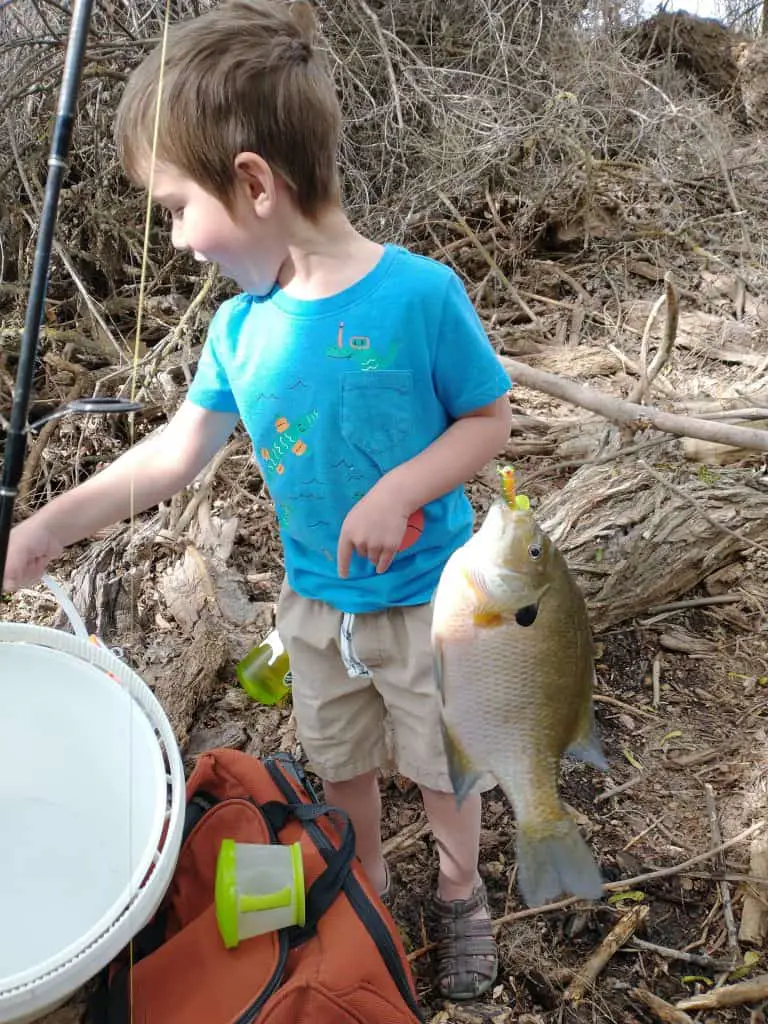
Fishing is an outdoor activity that is accessible to everyone with minimal equipment and cost. No matter where you live in the United States there are fishing opportunities nearby. All you need to start fishing is a fishing license from the state you’re fishing in, a fishing rod and reel, and some simple fishing tackle. This article breaks down the costs of the basic equipment you’ll need to get started fishing. I’ll start by going over fishing license requirements and costs, then get into the gear you’ll need.
It’s actually quite affordable to start fishing, even if you don’t have any gear to start with. Most folks can get the basic gear they need for under \$100.
Total Cost to Start Fishing¶
First, I’ll need to make some basic assumptions about the species you’ll be fishing for and the fishing method you’ll be using to give accurate estimates of what it will cost to purchase the necessary tackle. I’ll assume that you’re primarily interested in catching bass, trout, and/or panfish and that you’ll be using bait. This profile should fit most beginning fishermen.
Given these assumptions, you’ll be able to get a license and a good set of equipment and start fishing for less than \$100 (in most cases). Throughout the rest of this article I’ll break down the costs so you can know what to expect to pay depending on where you live in the United States.
Fishing License Cost¶
A fishing license is a non-negotiable cost. You have to have a license to legally fish. The cost of a fishing license depends on where you live. Because wildlife are held in as a public trust by each state, each state sets its own bag limits, regulations, and license fees. This also means that license costs are different for residents of a state and non-residents. Legally, you can only be a resident of one state. By default this means you a non-resident (for fishing purposes) in 49 states.
In the United States, fishing licenses cost between \$6.00 and \$54.00 for residents. For non-residents, fishing licenses cost between \$22.50 and \$145.80.
At \$6.00, Hawaii has the lowest price for a resident fishing license while Delaware has the lowest non-resident price at \$22.50. Meanwhile, California has the highest-priced licenses for residents at \$54.00 and California has the highest-priced licenses for non-residents at \$145.80.
You can check out the table below to see how much fishing licenses cost for each state and if there are additional licenses, permits, or tags required for certain species. Please note that license fees and regulations change quite frequently, so be sure to check regulations for the state you’ll be fishing before purchasing a license or doing any fishing.
| State | Resident Price | Non-resident Price | Special Licenses/Tags |
|---|---|---|---|
| Alabama | $15.05 | $58.15 | Saltwater |
| Alaska | $20.00 | $100.00 | King Salmon |
| Arizona | $37.00 | $55.00 | – |
| Arkansas | $10.50 | $50.00 | Trout |
| California | $54.00 | $145.80 | Salmon, steelhead, sturgeon |
| Colorado | $36.71 | $102.40 | – |
| Connecticut | $32.00 | $63.00 | Salmon, trout |
| Delaware | $11.00 | $22.50 | Trout |
| Florida | $17.00 | $47.00 | Saltwater |
| Georgia | $15.00 | $50.00 | Trout |
| Hawaii | $6.00 | $26.00 | – |
| Idaho | $30.40 | $108.00 | Salmon, Steelhead |
| Illinois | $15.00 | $31.50 | Salmon, Trout |
| Indiana | $23.00 | $60.00 | Salmon, Trout |
| Iowa | $22.00 | $48.00 | Trout |
| Kansas | $27.50 | $52.50 | Paddlefish, Trout |
| Kentucky | $23.00 | $55.00 | Trout |
| Louisiana | $17.00 | $68.00 | Saltwater |
| Maine | $25.00 | $64.00 | – |
| Maryland | $20.50 | $30.50 | Saltwater, Trout |
| Massachusetts | $26.00 | $36.00 | Saltwater |
| Michigan | $26.00 | $76.00 | – |
| Minnesota | $25.00 | $51.00 | Trout |
| Mississippi | $25.00 | $60.00 | Saltwater |
| Missouri | $12.00 | $49.00 | – |
| Montana | $29.00 | $110.00 | – |
| Nebraska | $38.00 | $84.00 | – |
| Nevada | $40.00 | $80.00 | – |
| New Hampshire | $45.00 | $63.00 | Saltwater |
| New Jersey | $22.50 | $34.00 | – |
| New Mexico | $25.00 | $56.00 | – |
| New York | $25.00 | $50.00 | – |
| North Carolina | $16.00 | $32.00 | – |
| North Dakota | $19.00 | $50.00 | Paddlefish |
| Ohio | $25.00 | $50.96 | – |
| Oklahoma | $25.00 | $55.00 | Paddlefish |
| Oregon | $44.00 | $110.50 | Halibut, salmon, steelhead, sturgeon |
| Pennsylvania | $22.97 | $52.97 | Trout |
| Rhode Island | $21.00 | $38.00 | Saltwater, trout |
| South Carolina | $10.00 | $35.00 | Saltwater |
| South Dakota | $28.00 | $67.00 | – |
| Tennessee | $33.00 | $49.00 | Trout |
| Texas | $30.00 | $58.00 | Saltwater |
| Utah | $34.00 | $85.00 | – |
| Vermont | $28.00 | $54.00 | – |
| Virginia | $23.00 | $47.00 | Saltwater |
| Washington | $29.50 | $84.50 | Saltwater |
| West Virginia | $19.00 | $37.00 | Trout |
| Wisconsin | $20.00 | $50.00 | Salmon, trout |
| Wyoming | $27.00 | $102.00 | – |
Fishing Rod and Reel Cost¶
You’re going to need a rod and reel to start fishing. There are a lot of rod and reel options out there and it can be paralyzing to try to make a decision, especially if you’re not quite sure what you’re looking for. Let me make a suggestion. The Shakespeare Ugly Stick combo (see image below) is a great middle of the road option that will last for a long time. The Ugly Stick rod is nearly indestructible and will serve you well. It comes paired with a good reel that will give you years of use. For a setup that will serve you for many species I suggest a 6-7 foot medium action rod. If you’re focused on trout and/or panfish you can downsize to a light action rod (I still like rods in the 6-7 foot range, but you can go shorter if you like).
For a budget option you can get a Zebco Spincast combo. The Zebco combo costs about half as much as the Shakespeare combo. It’s going to be be best for bass, trout, and panfish and won’t be as durable as the Shakespeare, but it will get you started and it will catch fish. My first fishing rod and reel were similar to this combo and I caught plenty of fish! As a bonus the Zebco combo also comes with enought tackle that you can get right out and start fishing (you just might want some bait).
Fishing Tackle Cost¶
The only tackle you need to start is some hooks, weights, bait, and (maybe) floats. The specific hooks, weights, and bait will depend on the species you’re targeting. I’ll give some general suggestions that should put you in the right area regardless of your target species.
Bait¶
I recommend worms to start. Pretty much everything eats worms. They’re a staple bait for trout, panfish, and bass. If you’re targeting trout or bass I recommend using half of worm. For panfish use 1/4 of a worm, or even less. Panfish have small mouths, give them something they can get in their mouth easily. Worms are also relatively inexpensive. Your best bet is pick up worms at your local sporting goods store. Many gas stations, especially those near fishing destinations, will also sell worms and bait.
Hooks¶
You’ll need something to put your worm on, and that’s where hooks come in. For worms, I recommend a single bait-holder hook like the ones pictured below. For trout and panfish you’ll want to get a smaller size. I recommend size 6 or 8 (size 6 is larger than size 8). Larger numbers are smaller hook sizes until you get to sizes like 1/0 and 2/0. In this case the bigger the first number is the larger the hook (size 2/0 is larger than size 1/0).
Thread the worm on the hook like you would a soft plastic jig so that the tail naturally hangs out past the bend of the hook. The barbs on the hook shank will hold the worm in place and the free tail will help it maintain a life-like look.
Weights¶
There are two ways to fish your worm. On the bottom, or near the surface. To fish your worm on the bottom (which is a common way to fish for trout, and sometimes bass), you’ll need some weight. The weight will make sure the worm stays on the bottom and will help you get a longer cast.
The amount of weight you should use depends on if you’re fishing a moving or still water and the action of your rod. Most rods will have a suggested lure weight printed on them. For best results try to get the total of your bait and weights in that range.
I like to use removable split shot because they are easily clamped on to any portion of your line and can be removed and reused. Plus you can add multpile weights of different sizes to fine tune the weight for different fishing conditions.
Floats¶
If you have weights you don’t have to use a float, but you might want to. I like to use floats when fishing for panfish. They can also work well for trout and bass. The advantage of a float is that you can suspend your bait near the surface or above the bottom. This allows you to avoid potential snags and get your bait in front of this that are suspended. A float is also a great indicator of when you have a fish biting.
Depending on the float you use you may or may not want to use weight with it. I like to use weighted floats so that my bait can float naturally and the fish don’t feel additional resitance from weight on the line when they take a bite of the bait. My favorite float is the Rocket Bobber because it casts well (without any weight) and detects sensitive bites.
Conclusion¶
The exact cost to start fishing will vary a depending on where you live because of fishing license costs. But as you can see with the gear I’ve suggested, no matter where you live you should be able to start fishing for less than \$100. If you haven’t tried fishing before, give it a try! It’s a great way to experience the outdoors and bring home some dinner. Just be sure to be patient (with the fish and with yourself). It can take a little while to get some confidence in your fishing skills, but stick with it and you’ll catch fish!

